Financial Analysis of Fast Retailing Co. and Competitor Comparison
VerifiedAdded on 2022/12/27
|13
|2462
|26
Report
AI Summary
This report provides a detailed financial analysis of Fast Retailing Co. Limited, a Japanese company founded in 1963, focusing on its financial performance through ratio analysis. The analysis includes a comparison with its key competitor, H&M. The report examines various financial ratios, including gross profit ratio, net profit ratio, operating profit ratio, current ratio, quick ratio, fixed assets turnover ratio, total assets turnover ratio, and gearing ratio. The analysis covers the years 2019 and 2020, providing insights into the companies' profitability, liquidity, and asset utilization. The report interprets the trends and performance of both companies based on these ratios, providing a comparative view of their financial health and efficiency. The conclusion highlights areas where Fast Retailing Co. needs to improve its financial performance, especially in comparison to H&M, which generally demonstrates better financial metrics.
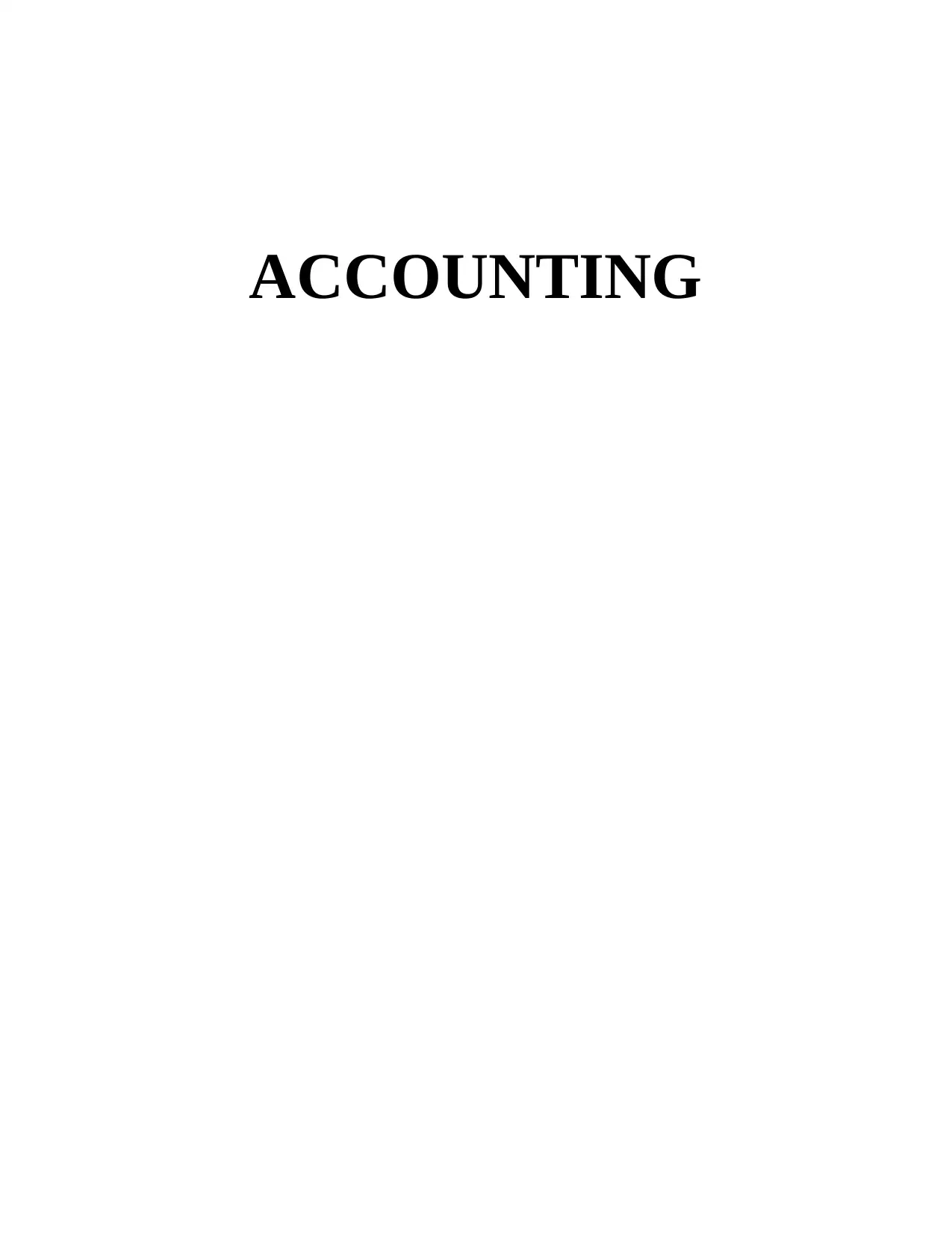
ACCOUNTING
Paraphrase This Document
Need a fresh take? Get an instant paraphrase of this document with our AI Paraphraser
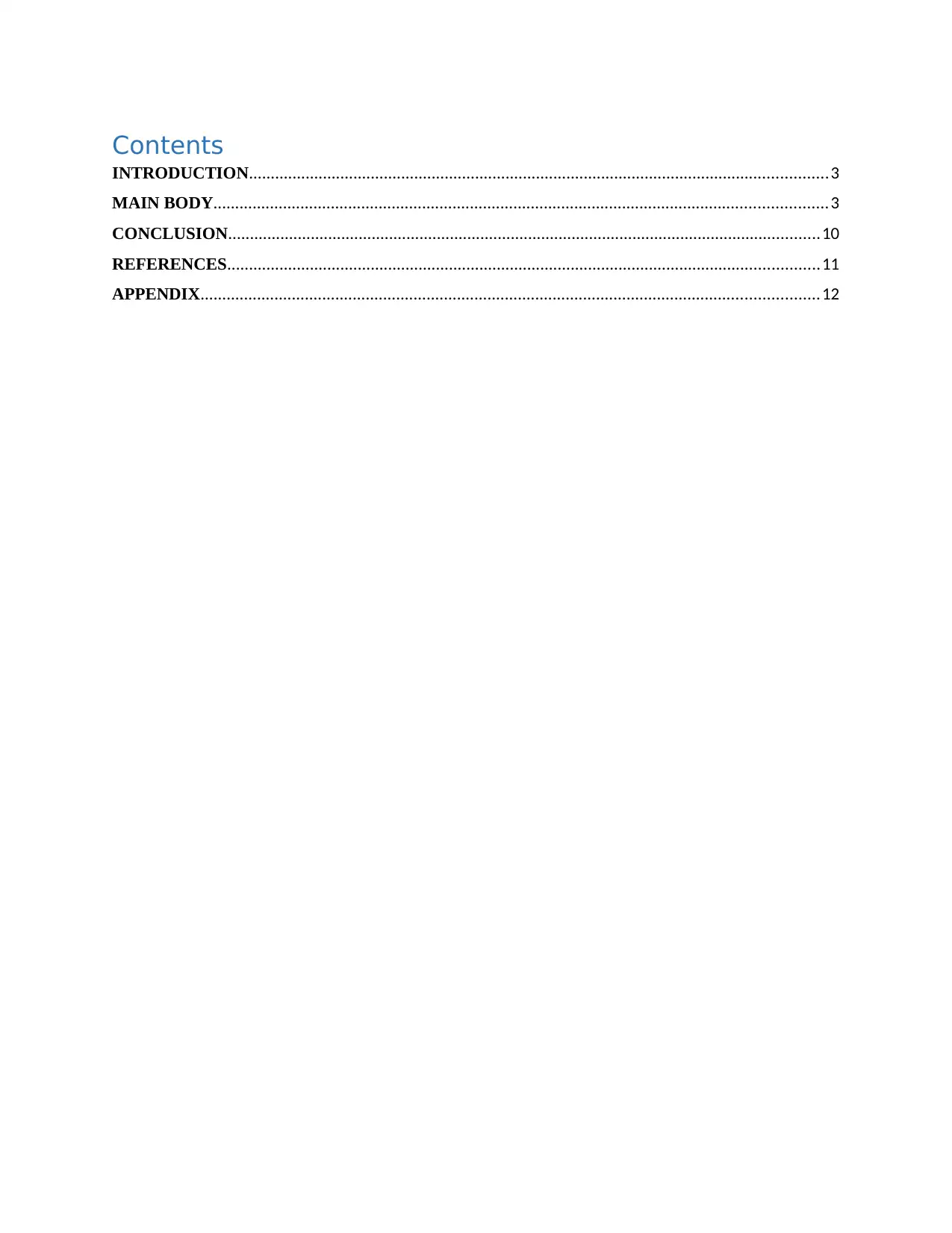
Contents
INTRODUCTION.....................................................................................................................................3
MAIN BODY.............................................................................................................................................3
CONCLUSION........................................................................................................................................10
REFERENCES........................................................................................................................................11
APPENDIX..............................................................................................................................................12
INTRODUCTION.....................................................................................................................................3
MAIN BODY.............................................................................................................................................3
CONCLUSION........................................................................................................................................10
REFERENCES........................................................................................................................................11
APPENDIX..............................................................................................................................................12
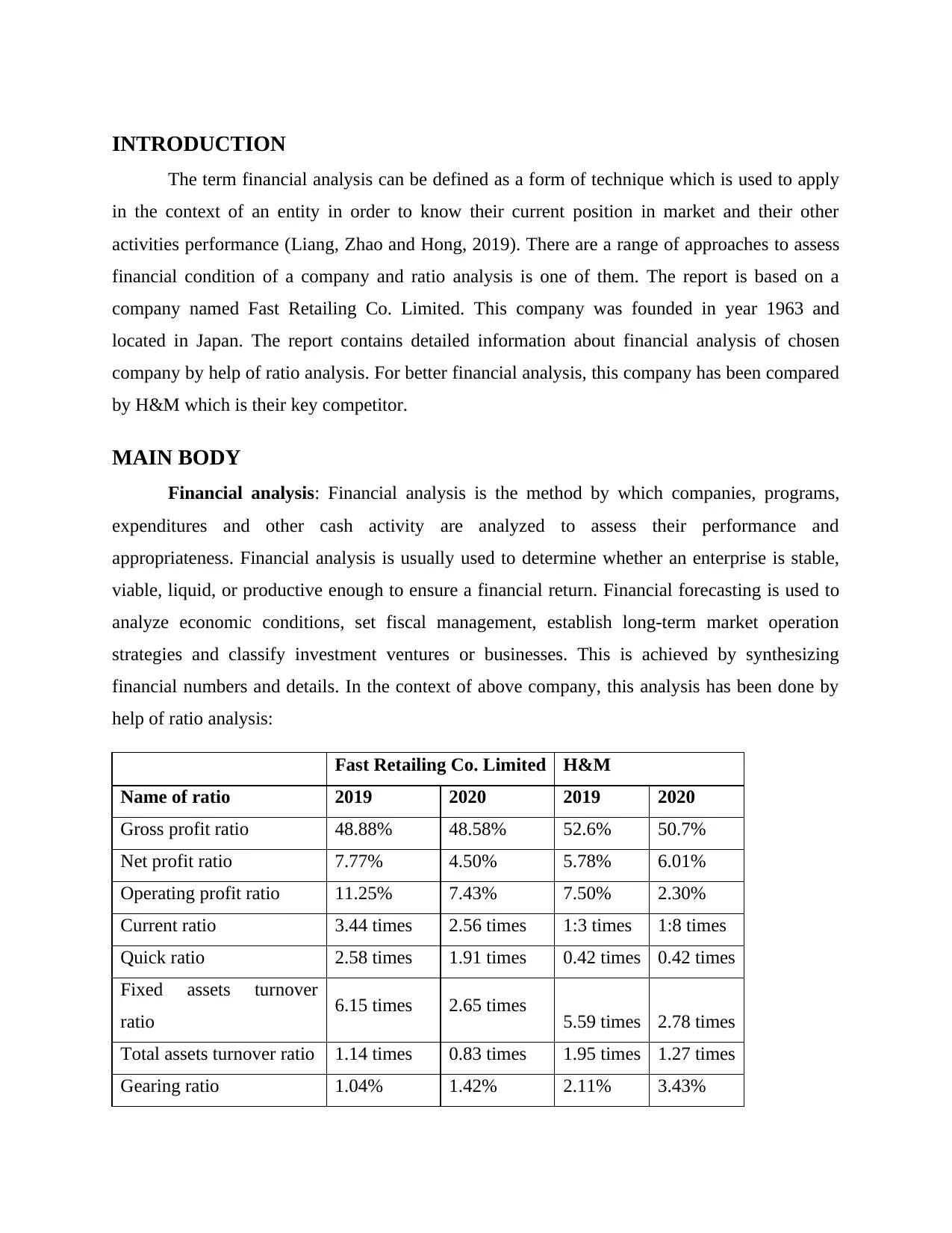
INTRODUCTION
The term financial analysis can be defined as a form of technique which is used to apply
in the context of an entity in order to know their current position in market and their other
activities performance (Liang, Zhao and Hong, 2019). There are a range of approaches to assess
financial condition of a company and ratio analysis is one of them. The report is based on a
company named Fast Retailing Co. Limited. This company was founded in year 1963 and
located in Japan. The report contains detailed information about financial analysis of chosen
company by help of ratio analysis. For better financial analysis, this company has been compared
by H&M which is their key competitor.
MAIN BODY
Financial analysis: Financial analysis is the method by which companies, programs,
expenditures and other cash activity are analyzed to assess their performance and
appropriateness. Financial analysis is usually used to determine whether an enterprise is stable,
viable, liquid, or productive enough to ensure a financial return. Financial forecasting is used to
analyze economic conditions, set fiscal management, establish long-term market operation
strategies and classify investment ventures or businesses. This is achieved by synthesizing
financial numbers and details. In the context of above company, this analysis has been done by
help of ratio analysis:
Fast Retailing Co. Limited H&M
Name of ratio 2019 2020 2019 2020
Gross profit ratio 48.88% 48.58% 52.6% 50.7%
Net profit ratio 7.77% 4.50% 5.78% 6.01%
Operating profit ratio 11.25% 7.43% 7.50% 2.30%
Current ratio 3.44 times 2.56 times 1:3 times 1:8 times
Quick ratio 2.58 times 1.91 times 0.42 times 0.42 times
Fixed assets turnover
ratio 6.15 times 2.65 times 5.59 times 2.78 times
Total assets turnover ratio 1.14 times 0.83 times 1.95 times 1.27 times
Gearing ratio 1.04% 1.42% 2.11% 3.43%
The term financial analysis can be defined as a form of technique which is used to apply
in the context of an entity in order to know their current position in market and their other
activities performance (Liang, Zhao and Hong, 2019). There are a range of approaches to assess
financial condition of a company and ratio analysis is one of them. The report is based on a
company named Fast Retailing Co. Limited. This company was founded in year 1963 and
located in Japan. The report contains detailed information about financial analysis of chosen
company by help of ratio analysis. For better financial analysis, this company has been compared
by H&M which is their key competitor.
MAIN BODY
Financial analysis: Financial analysis is the method by which companies, programs,
expenditures and other cash activity are analyzed to assess their performance and
appropriateness. Financial analysis is usually used to determine whether an enterprise is stable,
viable, liquid, or productive enough to ensure a financial return. Financial forecasting is used to
analyze economic conditions, set fiscal management, establish long-term market operation
strategies and classify investment ventures or businesses. This is achieved by synthesizing
financial numbers and details. In the context of above company, this analysis has been done by
help of ratio analysis:
Fast Retailing Co. Limited H&M
Name of ratio 2019 2020 2019 2020
Gross profit ratio 48.88% 48.58% 52.6% 50.7%
Net profit ratio 7.77% 4.50% 5.78% 6.01%
Operating profit ratio 11.25% 7.43% 7.50% 2.30%
Current ratio 3.44 times 2.56 times 1:3 times 1:8 times
Quick ratio 2.58 times 1.91 times 0.42 times 0.42 times
Fixed assets turnover
ratio 6.15 times 2.65 times 5.59 times 2.78 times
Total assets turnover ratio 1.14 times 0.83 times 1.95 times 1.27 times
Gearing ratio 1.04% 1.42% 2.11% 3.43%
⊘ This is a preview!⊘
Do you want full access?
Subscribe today to unlock all pages.

Trusted by 1+ million students worldwide
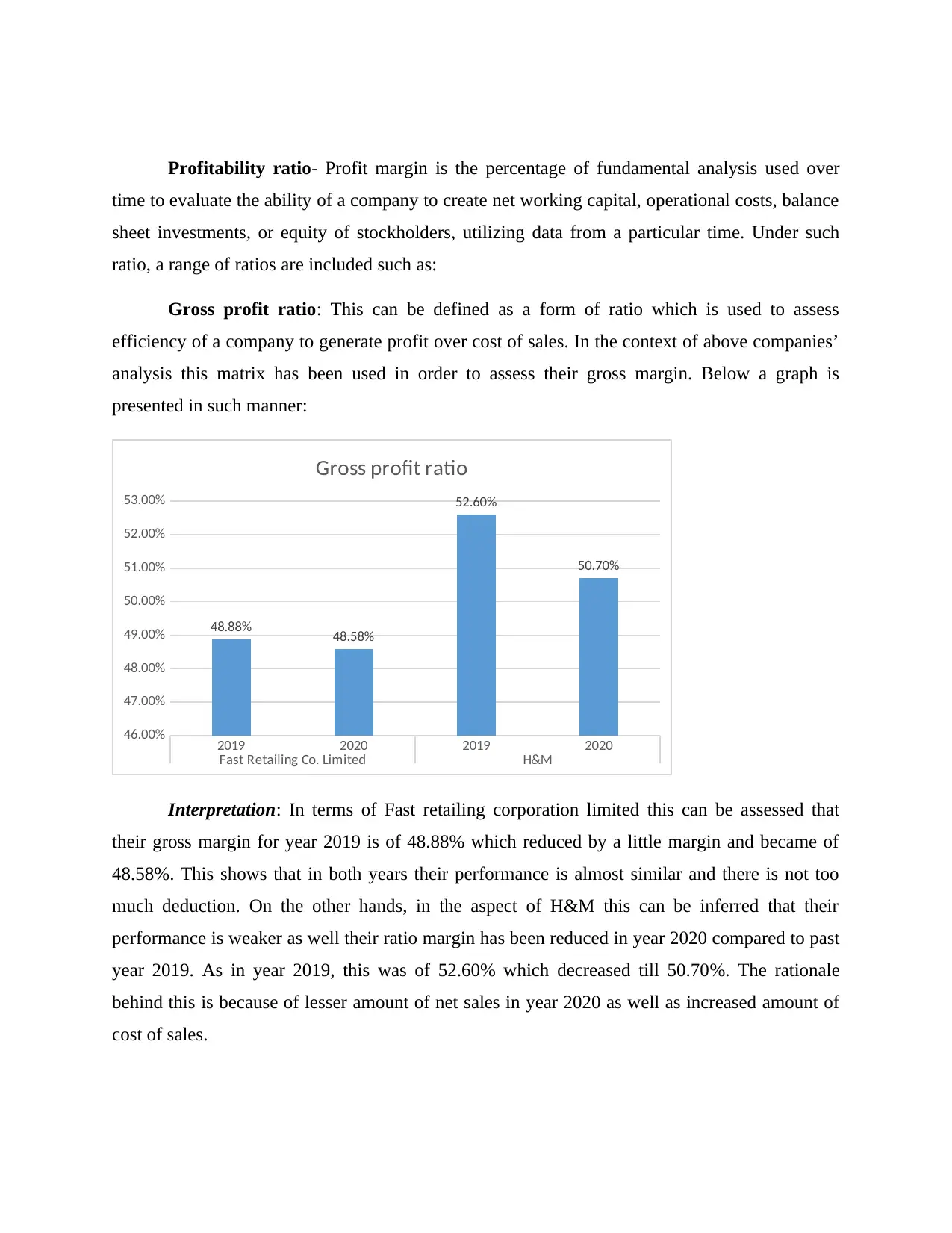
Profitability ratio- Profit margin is the percentage of fundamental analysis used over
time to evaluate the ability of a company to create net working capital, operational costs, balance
sheet investments, or equity of stockholders, utilizing data from a particular time. Under such
ratio, a range of ratios are included such as:
Gross profit ratio: This can be defined as a form of ratio which is used to assess
efficiency of a company to generate profit over cost of sales. In the context of above companies’
analysis this matrix has been used in order to assess their gross margin. Below a graph is
presented in such manner:
2019 2020 2019 2020
Fast Retailing Co. Limited H&M
46.00%
47.00%
48.00%
49.00%
50.00%
51.00%
52.00%
53.00%
48.88% 48.58%
52.60%
50.70%
Gross profit ratio
Interpretation: In terms of Fast retailing corporation limited this can be assessed that
their gross margin for year 2019 is of 48.88% which reduced by a little margin and became of
48.58%. This shows that in both years their performance is almost similar and there is not too
much deduction. On the other hands, in the aspect of H&M this can be inferred that their
performance is weaker as well their ratio margin has been reduced in year 2020 compared to past
year 2019. As in year 2019, this was of 52.60% which decreased till 50.70%. The rationale
behind this is because of lesser amount of net sales in year 2020 as well as increased amount of
cost of sales.
time to evaluate the ability of a company to create net working capital, operational costs, balance
sheet investments, or equity of stockholders, utilizing data from a particular time. Under such
ratio, a range of ratios are included such as:
Gross profit ratio: This can be defined as a form of ratio which is used to assess
efficiency of a company to generate profit over cost of sales. In the context of above companies’
analysis this matrix has been used in order to assess their gross margin. Below a graph is
presented in such manner:
2019 2020 2019 2020
Fast Retailing Co. Limited H&M
46.00%
47.00%
48.00%
49.00%
50.00%
51.00%
52.00%
53.00%
48.88% 48.58%
52.60%
50.70%
Gross profit ratio
Interpretation: In terms of Fast retailing corporation limited this can be assessed that
their gross margin for year 2019 is of 48.88% which reduced by a little margin and became of
48.58%. This shows that in both years their performance is almost similar and there is not too
much deduction. On the other hands, in the aspect of H&M this can be inferred that their
performance is weaker as well their ratio margin has been reduced in year 2020 compared to past
year 2019. As in year 2019, this was of 52.60% which decreased till 50.70%. The rationale
behind this is because of lesser amount of net sales in year 2020 as well as increased amount of
cost of sales.
Paraphrase This Document
Need a fresh take? Get an instant paraphrase of this document with our AI Paraphraser
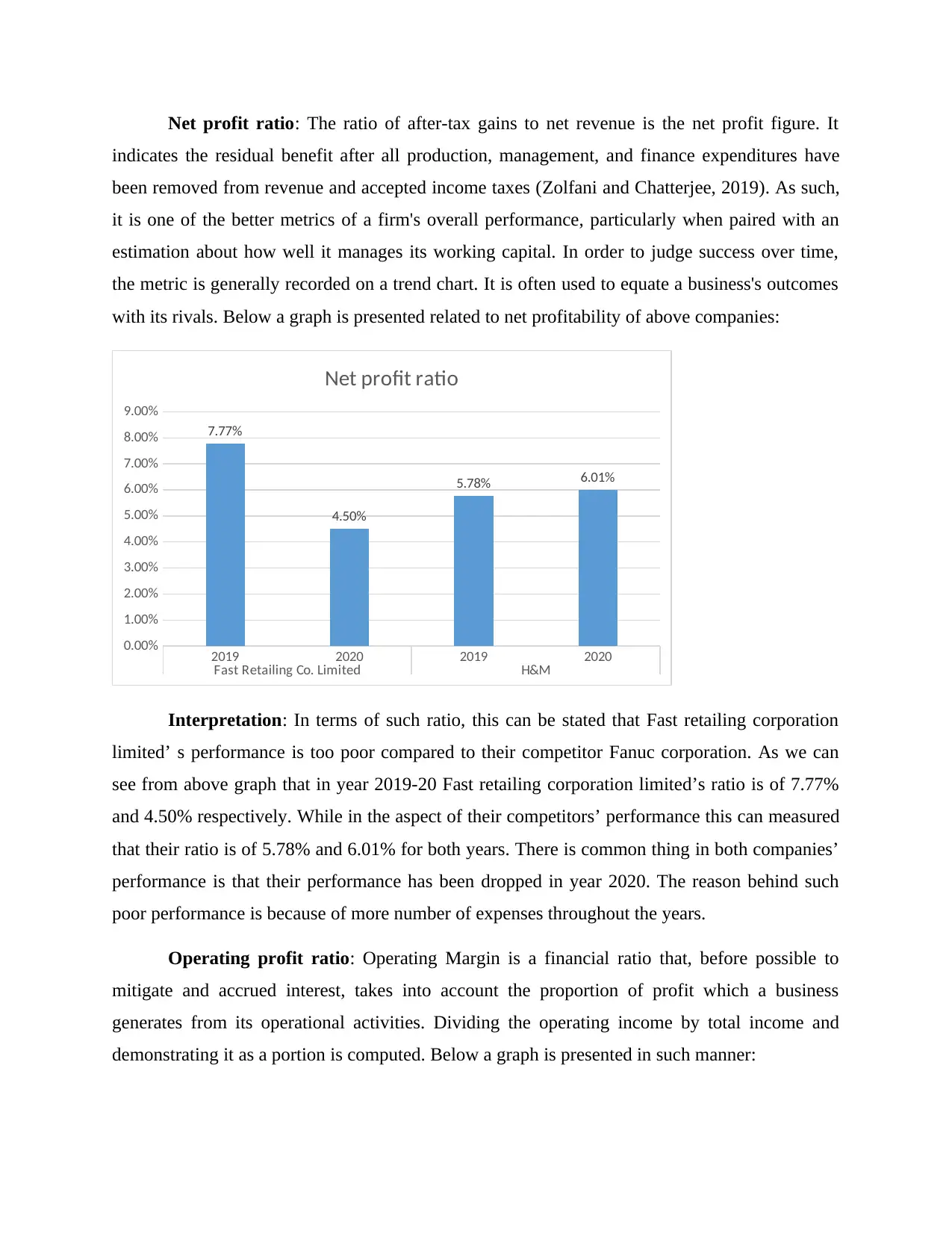
Net profit ratio: The ratio of after-tax gains to net revenue is the net profit figure. It
indicates the residual benefit after all production, management, and finance expenditures have
been removed from revenue and accepted income taxes (Zolfani and Chatterjee, 2019). As such,
it is one of the better metrics of a firm's overall performance, particularly when paired with an
estimation about how well it manages its working capital. In order to judge success over time,
the metric is generally recorded on a trend chart. It is often used to equate a business's outcomes
with its rivals. Below a graph is presented related to net profitability of above companies:
2019 2020 2019 2020
Fast Retailing Co. Limited H&M
0.00%
1.00%
2.00%
3.00%
4.00%
5.00%
6.00%
7.00%
8.00%
9.00%
7.77%
4.50%
5.78% 6.01%
Net profit ratio
Interpretation: In terms of such ratio, this can be stated that Fast retailing corporation
limited’ s performance is too poor compared to their competitor Fanuc corporation. As we can
see from above graph that in year 2019-20 Fast retailing corporation limited’s ratio is of 7.77%
and 4.50% respectively. While in the aspect of their competitors’ performance this can measured
that their ratio is of 5.78% and 6.01% for both years. There is common thing in both companies’
performance is that their performance has been dropped in year 2020. The reason behind such
poor performance is because of more number of expenses throughout the years.
Operating profit ratio: Operating Margin is a financial ratio that, before possible to
mitigate and accrued interest, takes into account the proportion of profit which a business
generates from its operational activities. Dividing the operating income by total income and
demonstrating it as a portion is computed. Below a graph is presented in such manner:
indicates the residual benefit after all production, management, and finance expenditures have
been removed from revenue and accepted income taxes (Zolfani and Chatterjee, 2019). As such,
it is one of the better metrics of a firm's overall performance, particularly when paired with an
estimation about how well it manages its working capital. In order to judge success over time,
the metric is generally recorded on a trend chart. It is often used to equate a business's outcomes
with its rivals. Below a graph is presented related to net profitability of above companies:
2019 2020 2019 2020
Fast Retailing Co. Limited H&M
0.00%
1.00%
2.00%
3.00%
4.00%
5.00%
6.00%
7.00%
8.00%
9.00%
7.77%
4.50%
5.78% 6.01%
Net profit ratio
Interpretation: In terms of such ratio, this can be stated that Fast retailing corporation
limited’ s performance is too poor compared to their competitor Fanuc corporation. As we can
see from above graph that in year 2019-20 Fast retailing corporation limited’s ratio is of 7.77%
and 4.50% respectively. While in the aspect of their competitors’ performance this can measured
that their ratio is of 5.78% and 6.01% for both years. There is common thing in both companies’
performance is that their performance has been dropped in year 2020. The reason behind such
poor performance is because of more number of expenses throughout the years.
Operating profit ratio: Operating Margin is a financial ratio that, before possible to
mitigate and accrued interest, takes into account the proportion of profit which a business
generates from its operational activities. Dividing the operating income by total income and
demonstrating it as a portion is computed. Below a graph is presented in such manner:
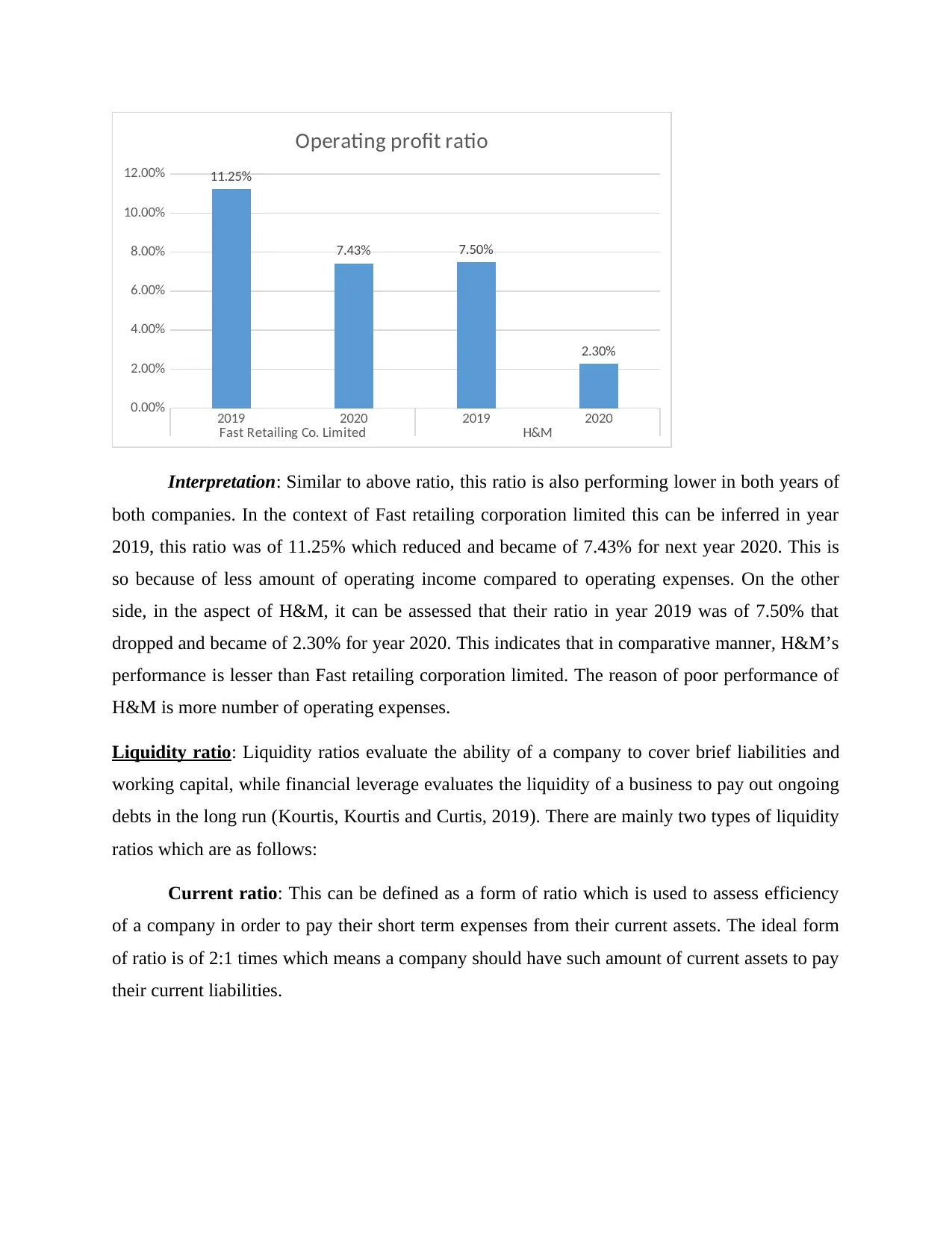
2019 2020 2019 2020
Fast Retailing Co. Limited H&M
0.00%
2.00%
4.00%
6.00%
8.00%
10.00%
12.00% 11.25%
7.43% 7.50%
2.30%
Operating profit ratio
Interpretation: Similar to above ratio, this ratio is also performing lower in both years of
both companies. In the context of Fast retailing corporation limited this can be inferred in year
2019, this ratio was of 11.25% which reduced and became of 7.43% for next year 2020. This is
so because of less amount of operating income compared to operating expenses. On the other
side, in the aspect of H&M, it can be assessed that their ratio in year 2019 was of 7.50% that
dropped and became of 2.30% for year 2020. This indicates that in comparative manner, H&M’s
performance is lesser than Fast retailing corporation limited. The reason of poor performance of
H&M is more number of operating expenses.
Liquidity ratio: Liquidity ratios evaluate the ability of a company to cover brief liabilities and
working capital, while financial leverage evaluates the liquidity of a business to pay out ongoing
debts in the long run (Kourtis, Kourtis and Curtis, 2019). There are mainly two types of liquidity
ratios which are as follows:
Current ratio: This can be defined as a form of ratio which is used to assess efficiency
of a company in order to pay their short term expenses from their current assets. The ideal form
of ratio is of 2:1 times which means a company should have such amount of current assets to pay
their current liabilities.
Fast Retailing Co. Limited H&M
0.00%
2.00%
4.00%
6.00%
8.00%
10.00%
12.00% 11.25%
7.43% 7.50%
2.30%
Operating profit ratio
Interpretation: Similar to above ratio, this ratio is also performing lower in both years of
both companies. In the context of Fast retailing corporation limited this can be inferred in year
2019, this ratio was of 11.25% which reduced and became of 7.43% for next year 2020. This is
so because of less amount of operating income compared to operating expenses. On the other
side, in the aspect of H&M, it can be assessed that their ratio in year 2019 was of 7.50% that
dropped and became of 2.30% for year 2020. This indicates that in comparative manner, H&M’s
performance is lesser than Fast retailing corporation limited. The reason of poor performance of
H&M is more number of operating expenses.
Liquidity ratio: Liquidity ratios evaluate the ability of a company to cover brief liabilities and
working capital, while financial leverage evaluates the liquidity of a business to pay out ongoing
debts in the long run (Kourtis, Kourtis and Curtis, 2019). There are mainly two types of liquidity
ratios which are as follows:
Current ratio: This can be defined as a form of ratio which is used to assess efficiency
of a company in order to pay their short term expenses from their current assets. The ideal form
of ratio is of 2:1 times which means a company should have such amount of current assets to pay
their current liabilities.
⊘ This is a preview!⊘
Do you want full access?
Subscribe today to unlock all pages.

Trusted by 1+ million students worldwide
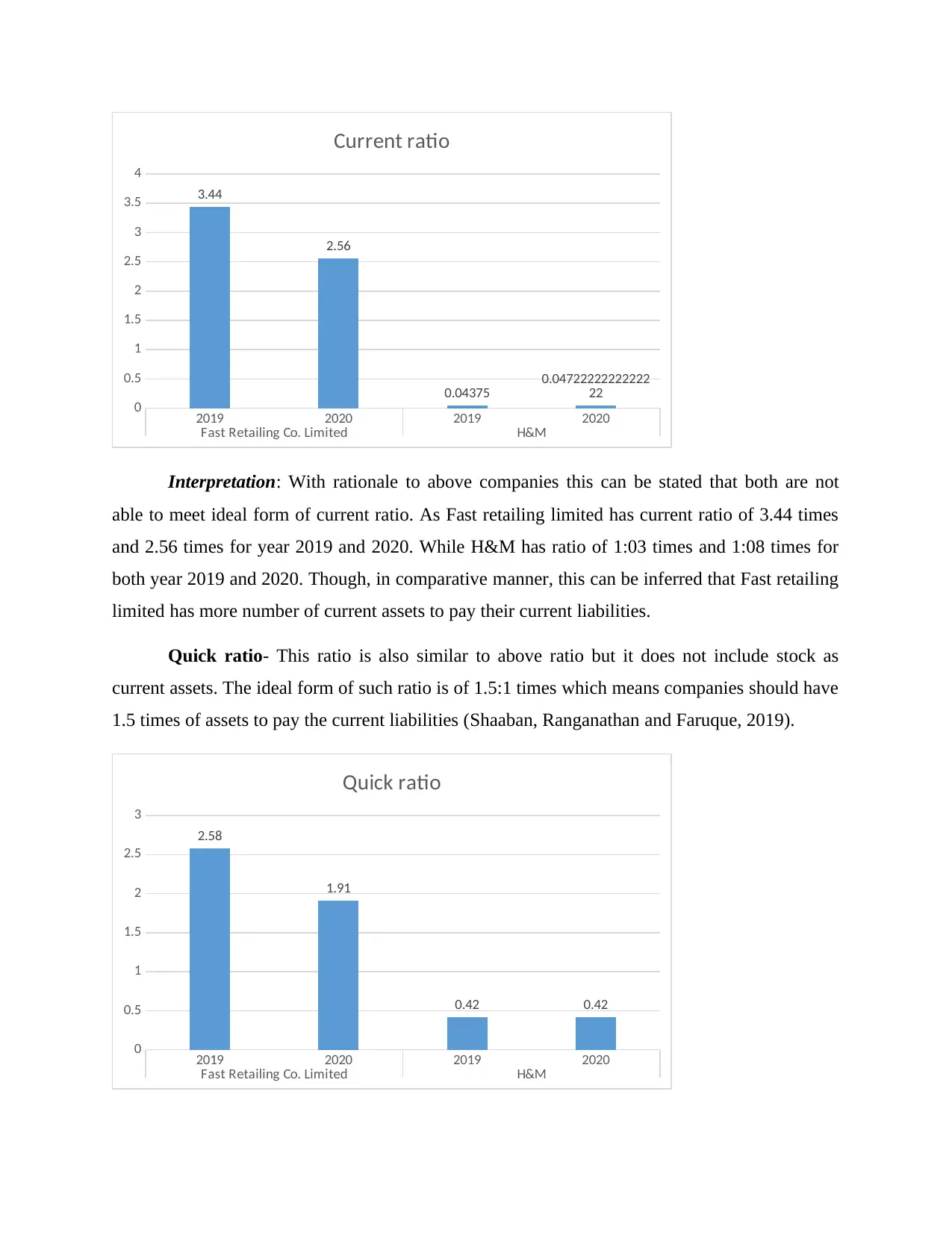
2019 2020 2019 2020
Fast Retailing Co. Limited H&M
0
0.5
1
1.5
2
2.5
3
3.5
4
3.44
2.56
0.04375
0.04722222222222
22
Current ratio
Interpretation: With rationale to above companies this can be stated that both are not
able to meet ideal form of current ratio. As Fast retailing limited has current ratio of 3.44 times
and 2.56 times for year 2019 and 2020. While H&M has ratio of 1:03 times and 1:08 times for
both year 2019 and 2020. Though, in comparative manner, this can be inferred that Fast retailing
limited has more number of current assets to pay their current liabilities.
Quick ratio- This ratio is also similar to above ratio but it does not include stock as
current assets. The ideal form of such ratio is of 1.5:1 times which means companies should have
1.5 times of assets to pay the current liabilities (Shaaban, Ranganathan and Faruque, 2019).
2019 2020 2019 2020
Fast Retailing Co. Limited H&M
0
0.5
1
1.5
2
2.5
3
2.58
1.91
0.42 0.42
Quick ratio
Fast Retailing Co. Limited H&M
0
0.5
1
1.5
2
2.5
3
3.5
4
3.44
2.56
0.04375
0.04722222222222
22
Current ratio
Interpretation: With rationale to above companies this can be stated that both are not
able to meet ideal form of current ratio. As Fast retailing limited has current ratio of 3.44 times
and 2.56 times for year 2019 and 2020. While H&M has ratio of 1:03 times and 1:08 times for
both year 2019 and 2020. Though, in comparative manner, this can be inferred that Fast retailing
limited has more number of current assets to pay their current liabilities.
Quick ratio- This ratio is also similar to above ratio but it does not include stock as
current assets. The ideal form of such ratio is of 1.5:1 times which means companies should have
1.5 times of assets to pay the current liabilities (Shaaban, Ranganathan and Faruque, 2019).
2019 2020 2019 2020
Fast Retailing Co. Limited H&M
0
0.5
1
1.5
2
2.5
3
2.58
1.91
0.42 0.42
Quick ratio
Paraphrase This Document
Need a fresh take? Get an instant paraphrase of this document with our AI Paraphraser

Interpretation: In regards to this ratio, company’s performance is same as above as in
year 2019, Fast retailing limited’ s ratio is of 2.58 times which reduced and became of 1.91 times
for next year 2020. On the other hands, in the context of H&M this can be assessed that this is of
0.42 times for year 2019 which increased and became of 0.42 times for year 2020. Though, in
comparative manner Fast retailing Limited’s performance is better than their competitor.
Assets utilization ratio: The proportion of asset turnover includes the amount of the amount of
revenue of a company comparative to the value of an asset (Perini, Strojnik and Camin, 2019).
The return on assets ratio could be used as an essential determinant at which a business generates
revenue by using its resources. This includes such ratios which are as:
Fixed assets turnover ratio:
2019 2020 2019 2020
Fast Retailing Co. Limited H&M
0
1
2
3
4
5
6
7
6.15
2.65
5.59
2.78
Fixed assets turnover ratio
Interpretation: In the context of above companies, this can be inferred that Fast retailing
limited’ s ratio is of 6.15 times which reduced and became of 2.65 times for next year.
WhileH&M’s performance is too poor as their ratio is lower for both year 2019-20. The reason
behind this is because of ineffective utilization of fixed assets.
Total assets turnover ratio:
year 2019, Fast retailing limited’ s ratio is of 2.58 times which reduced and became of 1.91 times
for next year 2020. On the other hands, in the context of H&M this can be assessed that this is of
0.42 times for year 2019 which increased and became of 0.42 times for year 2020. Though, in
comparative manner Fast retailing Limited’s performance is better than their competitor.
Assets utilization ratio: The proportion of asset turnover includes the amount of the amount of
revenue of a company comparative to the value of an asset (Perini, Strojnik and Camin, 2019).
The return on assets ratio could be used as an essential determinant at which a business generates
revenue by using its resources. This includes such ratios which are as:
Fixed assets turnover ratio:
2019 2020 2019 2020
Fast Retailing Co. Limited H&M
0
1
2
3
4
5
6
7
6.15
2.65
5.59
2.78
Fixed assets turnover ratio
Interpretation: In the context of above companies, this can be inferred that Fast retailing
limited’ s ratio is of 6.15 times which reduced and became of 2.65 times for next year.
WhileH&M’s performance is too poor as their ratio is lower for both year 2019-20. The reason
behind this is because of ineffective utilization of fixed assets.
Total assets turnover ratio:
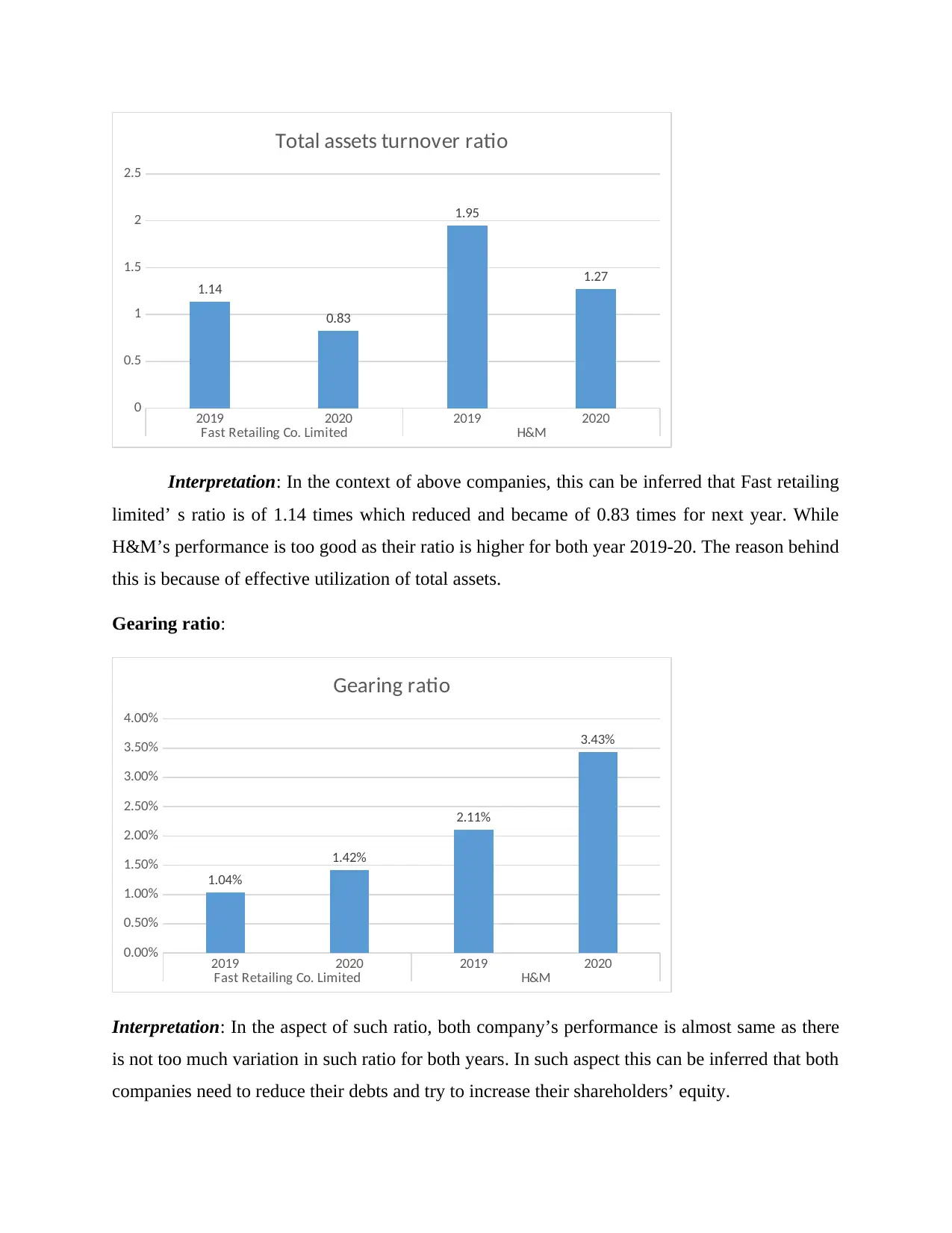
2019 2020 2019 2020
Fast Retailing Co. Limited H&M
0
0.5
1
1.5
2
2.5
1.14
0.83
1.95
1.27
Total assets turnover ratio
Interpretation: In the context of above companies, this can be inferred that Fast retailing
limited’ s ratio is of 1.14 times which reduced and became of 0.83 times for next year. While
H&M’s performance is too good as their ratio is higher for both year 2019-20. The reason behind
this is because of effective utilization of total assets.
Gearing ratio:
2019 2020 2019 2020
Fast Retailing Co. Limited H&M
0.00%
0.50%
1.00%
1.50%
2.00%
2.50%
3.00%
3.50%
4.00%
1.04%
1.42%
2.11%
3.43%
Gearing ratio
Interpretation: In the aspect of such ratio, both company’s performance is almost same as there
is not too much variation in such ratio for both years. In such aspect this can be inferred that both
companies need to reduce their debts and try to increase their shareholders’ equity.
Fast Retailing Co. Limited H&M
0
0.5
1
1.5
2
2.5
1.14
0.83
1.95
1.27
Total assets turnover ratio
Interpretation: In the context of above companies, this can be inferred that Fast retailing
limited’ s ratio is of 1.14 times which reduced and became of 0.83 times for next year. While
H&M’s performance is too good as their ratio is higher for both year 2019-20. The reason behind
this is because of effective utilization of total assets.
Gearing ratio:
2019 2020 2019 2020
Fast Retailing Co. Limited H&M
0.00%
0.50%
1.00%
1.50%
2.00%
2.50%
3.00%
3.50%
4.00%
1.04%
1.42%
2.11%
3.43%
Gearing ratio
Interpretation: In the aspect of such ratio, both company’s performance is almost same as there
is not too much variation in such ratio for both years. In such aspect this can be inferred that both
companies need to reduce their debts and try to increase their shareholders’ equity.
⊘ This is a preview!⊘
Do you want full access?
Subscribe today to unlock all pages.

Trusted by 1+ million students worldwide
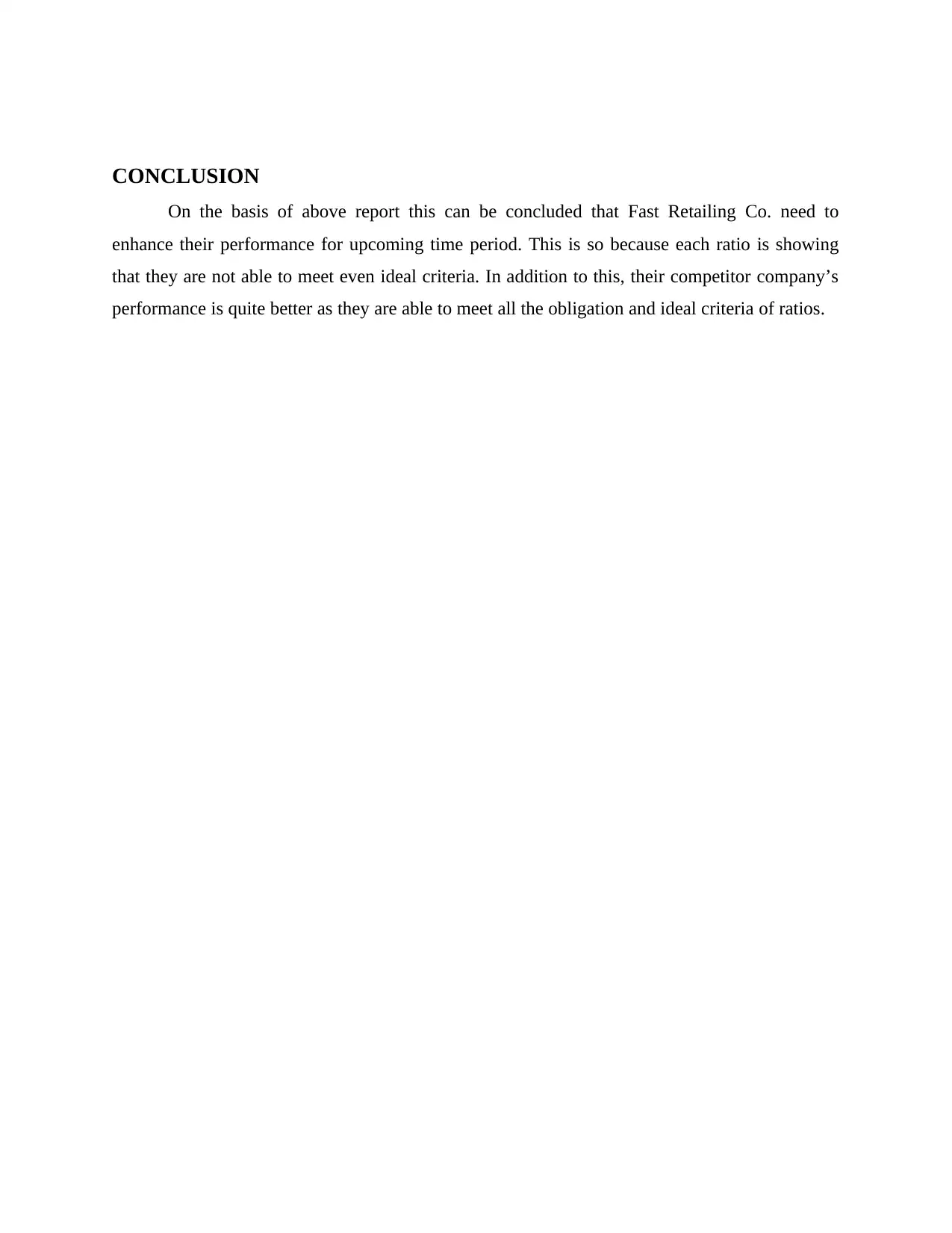
CONCLUSION
On the basis of above report this can be concluded that Fast Retailing Co. need to
enhance their performance for upcoming time period. This is so because each ratio is showing
that they are not able to meet even ideal criteria. In addition to this, their competitor company’s
performance is quite better as they are able to meet all the obligation and ideal criteria of ratios.
On the basis of above report this can be concluded that Fast Retailing Co. need to
enhance their performance for upcoming time period. This is so because each ratio is showing
that they are not able to meet even ideal criteria. In addition to this, their competitor company’s
performance is quite better as they are able to meet all the obligation and ideal criteria of ratios.
Paraphrase This Document
Need a fresh take? Get an instant paraphrase of this document with our AI Paraphraser

REFERENCES
Liang, W., Zhao, G. and Hong, C., 2019. Selecting the optimal mining method with extended
multi-objective optimization by ratio analysis plus the full multiplicative form
(MULTIMOORA) approach. Neural Computing and Applications, 31(10), pp.5871-5886.
Zolfani, S.H. and Chatterjee, P., 2019. Comparative evaluation of sustainable design based on
Step-Wise Weight Assessment Ratio Analysis (SWARA) and Best Worst Method
(BWM) methods: a perspective on household furnishing materials. Symmetry, 11(1),
p.74.
Kourtis, E., Kourtis, G. and Curtis, P., 2019. Αn Integrated Financial Ratio Analysis as a
Navigation Compass through the Fraudulent Reporting Conundrum: Α Case
Study. International Journal of Finance, Insurance and Risk Management, 9(1-2), pp.3-
20.
Perini, M., Pianezze, S., Strojnik, L. and Camin, F., 2019. C and H stable isotope ratio analysis
using solid-phase microextraction and gas chromatography-isotope ratio mass
spectrometry for vanillin authentication. Journal of chromatography A, 1595, pp.168-
173.
Shaaban, R., Ranganathan, P. and Faruque, S., 2019, March. Visible light communication
security vulnerabilities in multiuser network: power distribution and signal to noise ratio
analysis. In Future of Information and Communication Conference (pp. 1-13). Springer,
Cham.
Liang, W., Zhao, G. and Hong, C., 2019. Selecting the optimal mining method with extended
multi-objective optimization by ratio analysis plus the full multiplicative form
(MULTIMOORA) approach. Neural Computing and Applications, 31(10), pp.5871-5886.
Zolfani, S.H. and Chatterjee, P., 2019. Comparative evaluation of sustainable design based on
Step-Wise Weight Assessment Ratio Analysis (SWARA) and Best Worst Method
(BWM) methods: a perspective on household furnishing materials. Symmetry, 11(1),
p.74.
Kourtis, E., Kourtis, G. and Curtis, P., 2019. Αn Integrated Financial Ratio Analysis as a
Navigation Compass through the Fraudulent Reporting Conundrum: Α Case
Study. International Journal of Finance, Insurance and Risk Management, 9(1-2), pp.3-
20.
Perini, M., Pianezze, S., Strojnik, L. and Camin, F., 2019. C and H stable isotope ratio analysis
using solid-phase microextraction and gas chromatography-isotope ratio mass
spectrometry for vanillin authentication. Journal of chromatography A, 1595, pp.168-
173.
Shaaban, R., Ranganathan, P. and Faruque, S., 2019, March. Visible light communication
security vulnerabilities in multiuser network: power distribution and signal to noise ratio
analysis. In Future of Information and Communication Conference (pp. 1-13). Springer,
Cham.
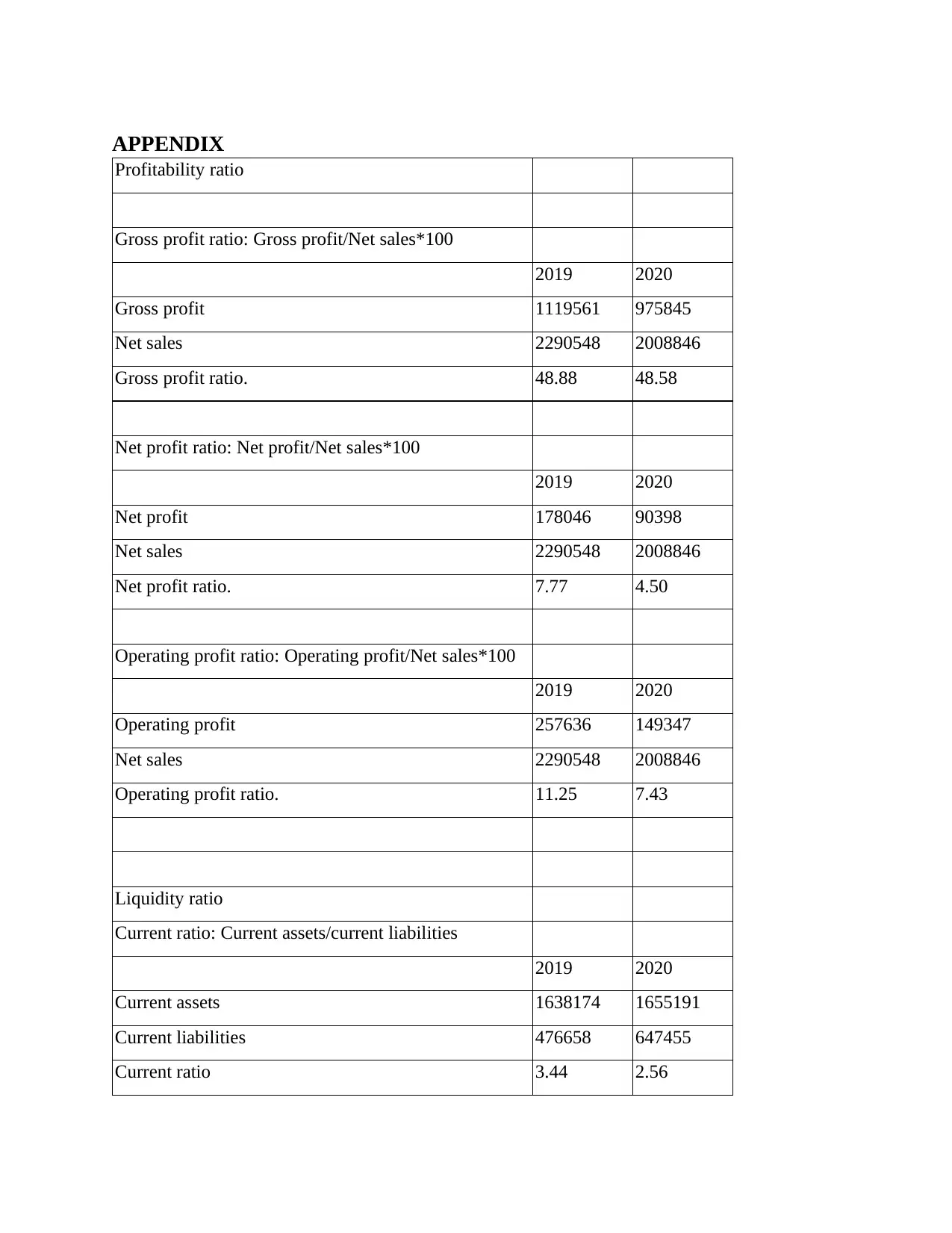
APPENDIX
Profitability ratio
Gross profit ratio: Gross profit/Net sales*100
2019 2020
Gross profit 1119561 975845
Net sales 2290548 2008846
Gross profit ratio. 48.88 48.58
Net profit ratio: Net profit/Net sales*100
2019 2020
Net profit 178046 90398
Net sales 2290548 2008846
Net profit ratio. 7.77 4.50
Operating profit ratio: Operating profit/Net sales*100
2019 2020
Operating profit 257636 149347
Net sales 2290548 2008846
Operating profit ratio. 11.25 7.43
Liquidity ratio
Current ratio: Current assets/current liabilities
2019 2020
Current assets 1638174 1655191
Current liabilities 476658 647455
Current ratio 3.44 2.56
Profitability ratio
Gross profit ratio: Gross profit/Net sales*100
2019 2020
Gross profit 1119561 975845
Net sales 2290548 2008846
Gross profit ratio. 48.88 48.58
Net profit ratio: Net profit/Net sales*100
2019 2020
Net profit 178046 90398
Net sales 2290548 2008846
Net profit ratio. 7.77 4.50
Operating profit ratio: Operating profit/Net sales*100
2019 2020
Operating profit 257636 149347
Net sales 2290548 2008846
Operating profit ratio. 11.25 7.43
Liquidity ratio
Current ratio: Current assets/current liabilities
2019 2020
Current assets 1638174 1655191
Current liabilities 476658 647455
Current ratio 3.44 2.56
⊘ This is a preview!⊘
Do you want full access?
Subscribe today to unlock all pages.

Trusted by 1+ million students worldwide
1 out of 13
Related Documents
Your All-in-One AI-Powered Toolkit for Academic Success.
+13062052269
info@desklib.com
Available 24*7 on WhatsApp / Email
![[object Object]](/_next/static/media/star-bottom.7253800d.svg)
Unlock your academic potential
Copyright © 2020–2025 A2Z Services. All Rights Reserved. Developed and managed by ZUCOL.





